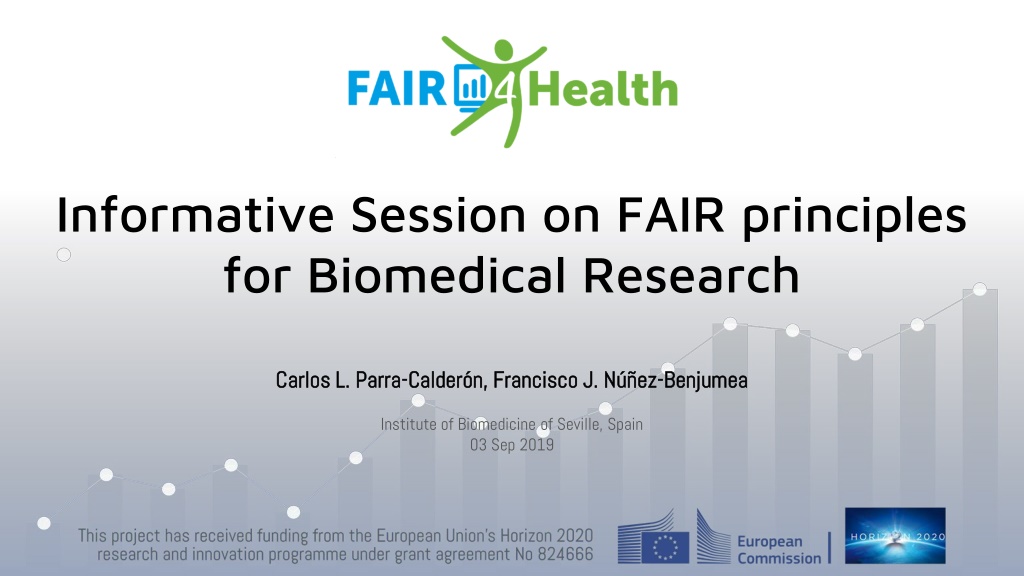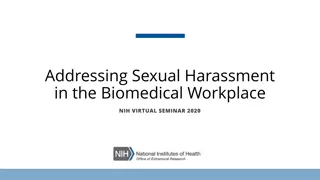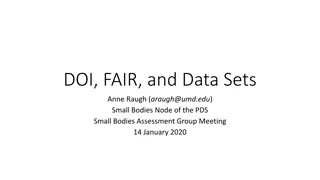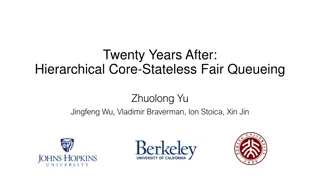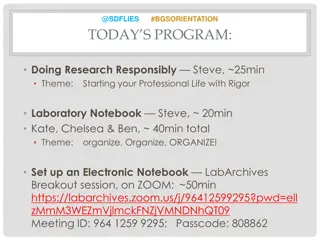Understanding FAIR Principles in Biomedical Research
The FAIR principles - Findable, Accessible, Interoperable, and Reusable - provide a framework for ensuring scientific data in biomedical research is managed and shared effectively. This informative session delves into the theory and practice of FAIR principles, emphasizing the importance of data quality, open data access, metadata standards, and data reusability. The FAIR Guiding Principles outline specific criteria for data management and stewardship in the scientific community. Practical insights on implementing FAIR principles in biomedical research organizations are also discussed.
Uploaded on Sep 29, 2024 | 0 Views
Download Presentation

Please find below an Image/Link to download the presentation.
The content on the website is provided AS IS for your information and personal use only. It may not be sold, licensed, or shared on other websites without obtaining consent from the author. Download presentation by click this link. If you encounter any issues during the download, it is possible that the publisher has removed the file from their server.
E N D
Presentation Transcript
Informative Session on FAIR principles for Biomedical Research Carlos L. Parra Carlos L. Parra- -Calder n, Francisco J. N ez Calder n, Francisco J. N ez- -Benjumea Benjumea Institute of Biomedicine of Seville, Spain 03 Sep 2019
Outline 1. Theory: 1. Theory: What FAIR stands for? Why go FAIR? Open data vs FAIR data FAIR data quality (metrics) FAIR repositories 2. Practice: 2. Practice: FAIR4Health: Objectives, use cases and datasets The FAIRification workflow Guidelines for Biomedical Research Organizations to implement a FAIR data policy 2
Outline 1. Theory: 1. Theory: What FAIR stands for? Why go FAIR? Open data vs FAIR data FAIR data quality (metrics) FAIR repositories 2. Practice: 2. Practice: FAIR4Health: Objectives, use cases and datasets The FAIRification workflow Guidelines for Biomedical Research Organizations to implement a FAIR data policy 3
The FAIR Guiding Principles FINDABLE F1. F1. (Meta)data are assigned a globally unique and persistent identifier F2. F2. Data are described with rich metadata (defined by R1 below) F3. F3. Metadata clearly and explicitly include the identifier of the data they describe F4. F4. (Meta)data are registered or indexed in a searchable resource ACCESSIBLE A1. A1. (Meta)data are retrievable by their identifier using a standardised communications protocol A1.1 A1.1 The protocol is open, free, and universally implementable A1.2 A1.2 The protocol allows for an authentication and authorisation procedure, where necessary A2. A2. Metadata are accessible, even when the data are no longer available INTEROPERABLE I1. I1. (Meta)data use a formal, accessible, shared, and broadly applicable language for knowledge representation. I2. I2. (Meta)data use vocabularies that follow FAIR principles I3. I3. (Meta)data include qualified references to other (meta)data REUSABLE R1. R1. Meta(data) are richly described with a plurality of accurate and relevant attributes R1.1. R1.1. (Meta)data are released with a clear and accessible data usage license R1.2. R1.2. (Meta)data are associated with detailed provenance R1.3. R1.3. (Meta)data meet domain-relevant community standards Wilkinson, M. D., et al. (2016). The FAIR Guiding Principles for Wilkinson, M. D., et al. (2016). The FAIR Guiding Principles for scientific data management and stewardship. scientific data management and stewardship. Scientific data Scientific data, 3 , 3 4
Outline 1. Theory: 1. Theory: What FAIR stands for? Why go FAIR? Open data vs FAIR data FAIR data quality (metrics) FAIR repositories 2. Practice: 2. Practice: FAIR4Health: Objectives, use cases and datasets The FAIRification workflow Guidelines for Biomedical Research Organizations to implement a FAIR data policy 5
FAIR in the current H2020 WP Explicitly mentioned in: 1. SC1-BHC-02-2019: Discovery of combinatorial therapies 2. SC1-HCO-02-2018: Data integration for personalised medicine 3. SC1-BHC-13-2019: Mining big data for infectious disease 4. SC1-HCO-20-2020: European Reference Networks 5. SC1-HCC-10-2020: Health research and innovation Cloud 6. Mobilisation of research funds in case of Public Health Emergencies Horizon 2020 Work Programme 2018 Horizon 2020 Work Programme 2018- -2020 https://ec.europa.eu/research/participants/data/ref/h2020/wp/2018- 2020/main/h2020-wp1820-health_en.pdf 2020 and more is to come in the upcoming Horizon Europe WP 7
Use of FAIR data in Health FAIR data in health (PubMed, 2018) From: From: https://fairsharing.org https://fairsharing.org (Aug 2019) (Aug 2019) 8
Outline 1. Theory: 1. Theory: What FAIR stands for? Why go FAIR? Open data vs FAIR data FAIR data quality (FAIR metrics) FAIR repositories 2. Practice: 2. Practice: The FAIR4Health Project The FAIRification workflow Guidelines for Biomedical Research Organizations to implement a FAIR data policy 9
Open Data vs FAIR Data FAIR Data is NOT Open Data Managed Data FAIR data Open Data Source Source: S. Venkataraman (Digital Curation Centre, Univ. of Edinburgh) Guidelines of FAIR Data Management in H2020 Guidelines of FAIR Data Management in H2020 10
Outline 1. Theory: 1. Theory: What FAIR stands for? Why go FAIR? Open data vs FAIR data FAIR data quality (FAIR metrics) FAIR repositories 2. Practice: 2. Practice: The FAIR4Health Project The FAIRification workflow Guidelines for Biomedical Research Organizations to implement a FAIR data policy 11
FAIR metrics Assess the degree of FAIRness of a resource: https://github.com/FAIRMetrics/Metrics/blob/master/MaturityIndicators/Gen1/ALL.pdf Wilkinson, M. D., et al. (2018). A design framework and exemplar Wilkinson, M. D., et al. (2018). A design framework and exemplar metrics for FAIRness. metrics for FAIRness. Scientific data Scientific data, 5 , 5 12
Outline 1. Theory: 1. Theory: What FAIR stands for? Why go FAIR? Open data vs FAIR data FAIR data quality (FAIR metrics) FAIR repositories 2. Practice: 2. Practice: The FAIR4Health Project The FAIRification workflow Guidelines for Biomedical Research Organizations to implement a FAIR data policy 13
FAIR repositories FAIR data HLEG: https://ec.europa.eu/info/sites/info/files/turning_fair_into_reality_1.pdf Rec. 20: Deposit in Trusted Digital Repositories Research data should be made available by means of Trusted Digital Repositories, and where possible in those with a mission and expertise to support a specific discipline or interdisciplinary research community. https://fairsharing.org Rec. 9: Develop assessment frameworks to certify FAIR services Data services must be encouraged and supported to obtain certification, as frameworks to assess FAIR services emerge. Existing community- endorsed methods to assess data services, in particular CoreTrustSeal (CTS) for trusted digital repositories, should be used as a starting point to develop assessment frameworks for FAIR services. Repositories that steward data for a substantial period of time should be encouraged and supported to achieve CTS certification. https://re3data.org https://www.nature.com/sdata/policies/repositories 14
Outline 1. Theory: 1. Theory: What FAIR stands for? Why go FAIR? Open data vs FAIR data FAIR data quality (FAIR metrics) FAIR repositories 2. Practice: 2. Practice: The FAIR4Health Project The FAIRification workflow Guidelines for Biomedical Research Organizations to implement a FAIR data policy 15
Improving Health Research in EU through FAIR data OBJECTIVES OBJECTIVES To facilitate and encourage facilitate and encourage the EU Health Research community to FAIRify, share and reuse to FAIRify, share and reuse their datasets derived from publicly funded research initiatives through the demonstration of the potential impact that such strategy will have on health outcomes and health research. 1. OUTREACH STRATEGY AT EU LEVEL 1. OUTREACH STRATEGY AT EU LEVEL 2. FAIR DATA CERTIFICATION ROADMAP 2. FAIR DATA CERTIFICATION ROADMAP 3. TECHNOLOGICAL PLATFORM 3. TECHNOLOGICAL PLATFORM 4. DEMONSTRATE POTENTIAL IMPACT 4. DEMONSTRATE POTENTIAL IMPACT EC funding: 2,999,053.75 2,999,053.75 @FAIR4Health www.fair4health.eu
Demonstrators Innovative eHealth services based on FAIR data reuse # #1 1 To support the discovery triggers triggers and and disease disease association comorbid patients reproducibility reproducibility of of research research. # #2 2 To develop and pilot a prediction days days readmission readmission risk risk in complex chronic patients discovery of of disease association patterns and demonstrate demonstrate disease onset patterns in onset prediction service service for for 30 30- - the the 17
Datasets Health and social care data from 5 million 5 million of subjects 18
FAIR4Health Vision eHealth Provider eHealth Provider eHealth Provider eHealth Services Providers Healthcare Providers Healthcare Provider Healthcare Provider Open Community Research Institution Research Institution Research Institution Health Research Institutions Health Reseach Institutions 19
Outline 1. Theory: 1. Theory: What FAIR stands for? Why go FAIR? Open data vs FAIR data FAIR data quality (FAIR metrics) FAIR repositories 2. Practice: 2. Practice: The FAIR4Health Project The FAIRification workflow Guidelines for Biomedical Research Organizations to implement a FAIR data policy 20
FAIRification workflow RAW RAW FAIR FAIR 21
FAIRification workflow Raw data analysis Curation and validation Anonymisation RAW RAW License attribution Make data linkable Semantic modeling Data Metadata aggregation Archiving FAIR FAIR versioning 22
Outline 1. Theory: 1. Theory: What FAIR stands for? Why go FAIR? Open data vs FAIR data FAIR data quality (FAIR metrics) FAIR repositories 2. Practice: 2. Practice: The FAIR4Health Project The FAIRification workflow Guidelines for Biomedical Research Organizations to implement a FAIR data policy 23
Principles 01 The implementation of FAIR policy implies to manage a complex change Strategic Vision There are no policies without resources and incentives supported by the needed infrastructure 02 Resources 03 Need to count with right knowledge and skills about FAIR data and research data management Skills The FAIR policy implementation must follow a clear action plan, identifying main actors and a credible timeline 04 Action Plan 05 The FAIR policy must be written down and approved by the institution Approval 24
Guidelines: 10 Steps 2. Responsible Team 3. Raise Awareness 4. Data Infrastructure 5. Good Practices 1. Vision and Objectives Describe current research, funders and their policies, research outcomes and infrastructure. Define the objectives of the policy. Adoption of overcoming mechanisms to enhance data sharing Design an action plan State resources and a feasible timeline Provide training and assistance to researchers. Definition of skills and a training programme Identify and describe data storage and architecture. Provision of tools to make data FAIR. Research outcomes should be deposited in trustworthy repos. Establish responsible RDM practices. Define FAIR for implementation. Creation of standard institutional template for DMP 25
Guidelines: 10 Steps 7. Standards 8. Incentivize 9. Implement 10. Assess 6. Openness Determine the level of openness, transparency and re- usability of research outputs, including licensing, provenance and mechanisms for data protection Technical decisions must be adopted regarding persistent IDs and metadata schemas for accessibility and interoperability. Include a technical analysis of domain- specific standards Devise credit and reward mechanisms to encourage researchers to apply the FAIR data policy 1. Write the policy 2. Submit for approval 3. Disseminate Provide mechanisms for FAIR data assessment within the institution. Re-align and consolidate with funders. 26
Key messages to take-away No FAIR no EU funding FAIR is NOT Open Institutional support 27
info@fair4health.eu fair4health.eu @fair4health 28
